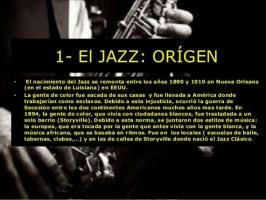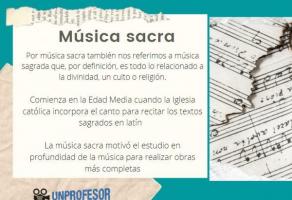Musical ROMANTICISM and its CHARACTERISTICS

Image: Slideshare
As humanity progresses through history, its events provide us with revelations, points of reflection, learnings that we acquire by interpreting what has happened to us as a society and as individuals. Art is a product that reflects the feelings and thoughts of each era and that is why we can learn a lot from history by analyzing its points of importance and expression. In this article by a TEACHER, we will learn about musical romanticism and its characteristics.
Index
- The era of musical Romanticism
- Romantic music characteristics
- Popular forms of musical romanticism
- Main composers of romanticism
The era of musical Romanticism.
Let us remember that we call it musical romanticism because it acquires a series of ideas and principles related to the era of romanticism. That is, as well as literature, painting and philosophy, music also inherited the characteristics of the ideology that was around in this period.
Romanticism is primarily a cultural movement.
It developed mainly in Europe during the 19th century and the first decades of the 20th century. The previous movements, the enlightenment and neoclassicism, were currents focused on the intellect and knowledge, closely related to politics and the social aspect. In contrast, romanticism places the utmost importance on individualism, personal expression and interpretation of reality. Romanticism seeks the expression of feelings and the conception of nature and life itself.These principles therefore influence the music, giving you freedom of expression to the authors to propose their personal ideas through composition.

Image: romanticism
Characteristics of romantic music.
We will already begin to know the characteristics of musical romanticism so that you learn to detect this type of composition. You should know that romanticism opens a gap to creation and individual expression, For this reason, the authors of this time had the opportunity to experiment by breaking certain norms of traditional music.
Before this time, the vast majority of compositions were made by musical commissions, that is, someone in the nobility or a position of power hired or sponsored a musician to create works that would meet their demands specific. It is for the first time the musician has the opportunity to create compositions for the mere pleasure of expression. Romantic artists eagerly sought originality, trying to get rid of musical customs.
Perhaps the most recognized central character of this movement is Ludwig van Beethoven, Austrian born in 1770, also popular for his strong character and his deafness in the last years of his life. Beethoven, among other musicians, began to have direct contact with the popular market. Many of his works would be published to be available to the public and the homes of the middle class, representing an important new source of money for composers and thus giving them greater independence economic and artistic.
Musical characteristics of romanticism
- Greater use of chromaticisms, harmonic changes and minor tonalities.
- Very colorful harmony, intense, sometimes ambiguous.
- Frequent use of modulation (change of tonality), which requires the viewer more attention.
- Expansion of musical range and variety.
- Growth in the importance of virtuosity. The implementation of very technical passages, with the aim that a solo musician can show off his skills. Franz Liszt He was noted for this quality on the piano, creating compositions for piano that were extremely difficult in terms of technique and performance.
- Inclusion of new instruments on the symphonic Orchestra such as the piccolo, the English horn, the contrabassoon and the tuba, among others.
- Increase in the size of the orchestra, greater number of musicians.
- Peak in the use of piano, both individually and in the symphony orchestra, thanks to its expressive quality.
- Variety in musical styles, including adaptations of folk dances and national elements.
- Promotion of improvisation.
- Appreciation of what exotic.

Image: Slideplayer
Popular forms of musical romanticism.
Now that you know the main characteristics of musical romanticism, let's find out which were the most used forms during romanticism:
- Night: Mysterious, sensitive musical piece, destined to be played at night. One of the most acclaimed forms of Chopin.
- Impromptu: Composition composed by improvisation.
- Waltz: Destined to dance with a slow rhythm. Although its origin comes from the s. XVIII, it is in romanticism where the form that we currently know with a measure of ¾ is specified.
- Fantasy: Another composition based on improvisation. It has the musical bases of the sonata but with greater freedoms. It is given to the development of themes including imitative and counterpoint characteristics.
- Prelude: Short composition that serves as an introduction to a major and longer work. It does not have a specific structure.
- Study: A piece composed for a solo musician, the study of a certain technical discipline, an exercise of difficult execution.
- Symphony: Composition for symphony orchestra that conventionally has 4 movements. Some musicians took more liberties, like Beethoven, who has composed symphonies with 5 movements.

Image: Slideplayer
Main composers of romanticism.
And to conclude this lesson of musical romanticism, we are going to offer you a complete list with the outstanding composers of this current in music. They are as follows:
- Ludvig Van Beethoven
- Hector Berlioz
- Johannes brahms
- Anton Bruckner
- Frederic Chopin
- Franz Liszt
- Felix mendelssohn
- Niccolo Paganini
- Franz schubert
- Robert Schumann
- Richard Strauss
- Giuseppe Verdi
- Richard Wagner
Although music has many objectives, the opportunity that romanticism offered to the musicians of the time is very interesting, opening a gap to individual expression. At the end of it all, art has as its ultimate goal the exposition of personal ideas and feelings.

Image: Slideshare
If you want to read more articles similar to Musical romanticism: characteristics, we recommend that you enter our category of Music history.



